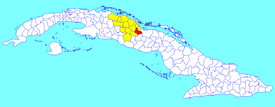Remedios, Cuba
|
Remedios (San Juan de los Remedios) |
|
|---|---|
| Municipality | |

Iglesia Mayor in Remedios
|
|
 Remedios municipality (red) within Villa Clara Province (yellow) and Cuba |
|
| Location of Remedios in Cuba | |
| Coordinates: 22°29′32″N 79°32′45″W / 22.49222°N 79.54583°WCoordinates: 22°29′32″N 79°32′45″W / 22.49222°N 79.54583°W | |
| Country |
|
| Province | Villa Clara |
| Established | 1513 |
| Area | |
| • Total | 560 km2 (220 sq mi) |
| Elevation | 25 m (82 ft) |
| Population (2004) | |
| • Total | 46,482 |
| • Density | 83.0/km2 (215/sq mi) |
| Time zone | EST (UTC-5) |
| Area code(s) | +53-42-39 |
Remedios (Spanish pronunciation: [reˈmeðjos]), also known as San Juan de los Remedios, is a city and municipality located 3 miles (4.8 km) from the northern coast of Cuba, in the center of the island. It is the oldest Spanish settlement in the former Las Villas province. It is now part of the province of Villa Clara. It was declared a City by Isabella II of Spain, when the Island was still a colony. Remedios is the Cradle of the Parrandas, possibly the Caribbean's largest and oldest traditional festivity. Its patrons are San Juan Bautista and the Virgin of the Buenviaje.
Remedios is located about 4 hours away by bus from Havana, around 50 minutes from Santa Clara and there is less than an hour from there to beach resorts in the Santa María - Las Brujas cays both situated north of the province. The municipality limits to the north with Caibarien, to the south with Camajuani and Placetas, and to the east with Yaguajay ( Sancti Spiritus)
It is recognized as the eighth oldest city in Cuba, but its real date of foundation has been obscured over time, and it may be the second Spanish settlement on the island. Historians place the foundation date sometime between 1513 and 1524 by Spanish nobleman Vasco Porcallo de Figueroa, founded by him on 13 April 1514. Documents reflect that this settlement was only preceded by Baracoa (1511) and (Bayamo)(1512). Considering these facts some believe it was actually founded before Trinidad (1514). Rumor has it that Vasco, in order to avoid tax payments to the crown, maintained the village hidden from the knowledge of the King of Spain as long as he could, but the village grew quickly, and at some point it had to be recognized. Through his wife, the daughter of the Cacique of Sabaneque, Vasco received a huge land grant as a personal fief from Gobernor Diego Velazquez as stipulated by Spanish law, therefore it had no municipal entity to govern the town. Upon Vasco's death in Puerto Principe in 1550 the town obtained its charter.
...
Wikipedia

